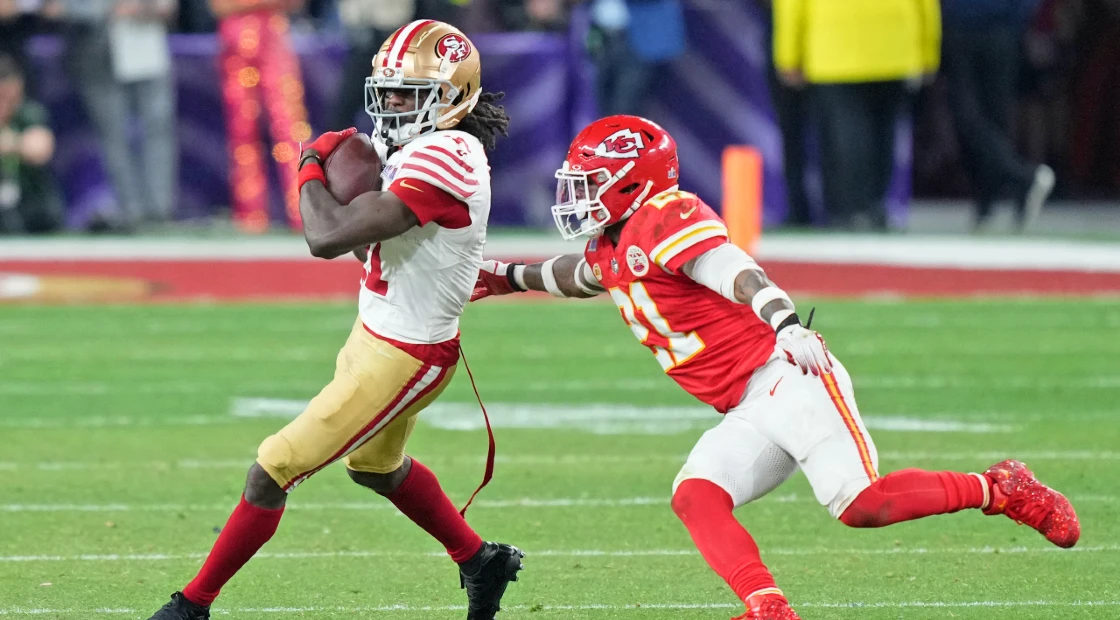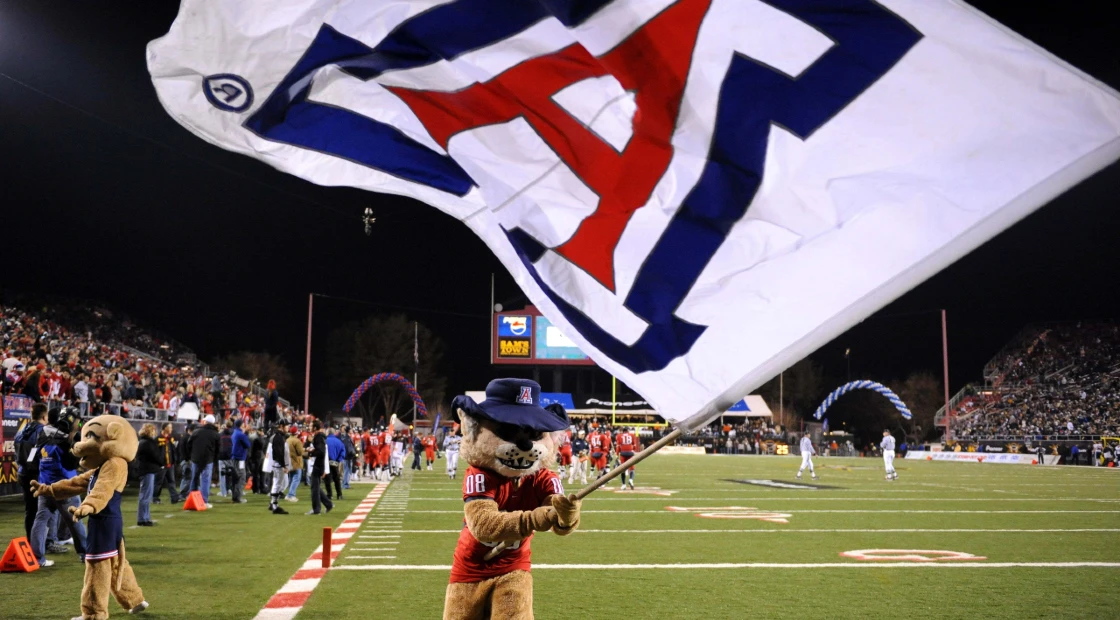All 16 legal Arizona sportsbooks launched in July 2024 for sports betting.
Legal Arizona sports betting has now expanded to 16 online sportsbooks. Check out all the best AZ sportsbooks and betting sites available below today.Best AZ Sportsbooks 2024
Below are some of the best Arizona sports betting sites reviewed by our experts. 1
Best Choice
Must be 21+ and present in AZ. T&Cs apply.
2
Bonus Bets Expire in 7 Days. One New Customer Offer Only. Must be 21+ to participate & present in AZ. Gambling problem? Call 1-800-NEXT-STEP. Visit BetMGM.com for Terms & Conditions. US promotional go-bets not available in NY, NV, or Puerto Rico.
3
Must be a new verified Betway customer & present in AZ. 21+. Opt-in may be req'd. Make your first min. deposit of $10+, place a wager up to $250 (with odds of –300 (1.33) or greater (i.e. -300, -150, +150, etc.)) and receive up to $250 as bonus bet funds if the wager loses. Wager must be settled within 7 days from new account opening Gambling problem? Call 1-800-NEXT-STEP (AZ).
4
5
Must be 21+ to participate & present in Arizona. Gambling Problem? Call 1-800-NEXT-STEP. Deposit required. Bonus Bets winnings are added to Bonus Bets balance. Bonus Bet wager excluded from returns. T&Cs Apply.
6
Must be 21+ to participate & present in Arizona. T&Cs apply. Play Responsibly. Gambling problem? Call 1-800-522-4700
7
8
Offered by Seminole Hard Rock Digital, LLC. Must be 21+ and physically present in AZ to play. T&Cs Apply. In AZ call 1-800-NEXT-STEP or text NEXTSTEP to 53342.
9
Must be 21+ to participate & present in Arizona. T&Cs apply. Gambling Problem? Call 1-800-NEXT-STEP.
Here are some quick facts and information about sports betting in Arizona.
On April 12th, 2021, the state Senate passed the betting bill HB 2772, and both retail and online sports betting became legal in Arizona.| Is Arizona Sports Betting Legal? | Yes, launched in September 2021 |
| ⭐️ Total Legal Sportsbooks in AZ: | 16 (as of July 3, 2024) |
| Sports Gambling Age: | 21 years old |
| Are Online Casinos Legal? | No, online casino gambling isn’t legal in Arizona |
| ﹪ AZ Sports Betting Tax Rate: | 10% in 2024 |
| Latest Arizona Betting News: | AZ Dept. of Gaming Opens Licensing Window |
| ️ Gambling Regulator in Arizona: | Arizona Department of Gaming |
| Gambling Help Line: | 1-800-NEXT-STEP |

Who is accountable for the legalization of sportsbook operators in Arizona?
After Gov. Doug Ducey signed the bill legalizing sports betting in Arizona, sports gambling needed only to have appropriate regulations set up. The Arizona Department of Gaming is in charge of sports betting legislation. The Arizona Department of Gaming:- The licensing system is established and 20 licenses are granted to professional franchises and tribal casinos.
- The license fees include an initial payment of $750,000, an application fee of $100,000, and an annual renewal fee of $150,000.
- Online sports betting activity is subject to a 10% tax rate, while retail sports betting activity is subject to an 8% tax rate.
- Manages the operations of casinos, lotteries, sportsbooks, and other gambling activities within the state.
Arizona Sports Betting Legislation Timeline
Here is a timeline of the path to legal sports gambling in Arizona.- Arizona officially launched legal sports betting on September 9, 2021, permitting gamblers to create accounts with licensed sportsbooks after the Arizona Department of Gaming issued 20 licenses.
- On April 15, 2021, Arizona Governor Doug Ducey approved HB 2772, the state’s sports betting legislation, making it law.
- After negotiations with tribal representatives and debates in the legislature, the sports betting bill (HB 2772) was passed by a vote of 23-6 in the state senate on April 12, 2021.
- The United States Supreme Court’s decision on May 14, 2018, to overturn the Professional and Amateur Sports Protection Act has resulted in the nationwide legalization of sports betting.
Keep yourself informed with the newest updates on Arizona sports betting news.
- On June 10, the Arizona Department of Gaming declared that they would commence the state’s licensing process in July to issue four available licenses to new sportsbooks.
- Unibet ceased operations in Arizona on June 4, reducing the total number of sportsbooks in the state to 16.
- On April 29, it was announced that Arizona’s betting handle for February 2024 had increased by 4.6% compared to the previous year.
- In November, Arizona reached a historic milestone by exceeding $700 million in betting handle for the first time, totaling $713,586,703.
- The ADG made the announcement on January 16 that they will begin accepting applications for event wagering licenses in February. These licenses are specifically reserved for Arizona Tribes, with one license guaranteed for an Arizona Sports Franchise.
- On January 14th, Jedd Fisch, the head football coach of the Arizona Wildcats, announced his departure to become the head coach of the Washington Huskies Football program. Fisch guided the Wildcats to a 10-3 record and a win in the Alamo Bowl before taking on his new role.
- ESPN BET, in collaboration with PENN Entertainment, is set to launch in Arizona on November 14, 2023.
- On November 2, 2023, PENN Entertainment revealed that ESPN BET is set to launch on November 14, 2023.
- In August 2023, sports betting in Arizona brought in revenue of $31.7 million, with a total handle of $358.9 million, as reported by the Arizona Department of Gaming.
Arizona Sportsbooks Directory – July 2024
We reviewed the current 16 Arizona sportsbooks and picked the best based on various features. Below we noted something we believe is a strength for each, ranging from the best sportsbook for new bettors to which operator has the best promo in the market.| ⭐ Caesars Sportsbook Arizona | Best for Loyalty Perks |
| ⭐ BetMGM Sportsbook Arizona | Top Overall Sportsbook |
| ⭐ Betway Arizona | Best for International Wagers |
| ⭐ DraftKings Sportsbook Arizona | Best for Betting Variety |
| ⭐ bet365 Arizona | Best for Live Betting |
| ⭐ Fanatics Sportsbook Arizona | Newest Sportsbook |
| ⭐ FanDuel Sportsbook Arizona | Top Mobile App |
| ⭐ Hard Rock Bet Arizona | Most Unique Promo |
| ⭐ BetRivers Arizona | Best Ongoing Promotions |
| ⭐ ESPN BET Arizona | Best for Recurring User Bonuses |
| ⭐ SaharaBets Arizona | Best for Desktop Users |
| ⭐ Superbook Arizona | Best Interface |
| ⭐ Betfred Arizona | Most Historical |
| ⭐ Desert Diamond Arizona | Good User Experience |
| ⭐ Bally Bet Arizona | Competitive Odds |
| ⭐ Golden Nugget Arizona | Best for Brick-and-Mortar Casino Users |
| ✅ App Rankings Last Verified | July 3, 2024 |
What are the factors that contribute to the trustworthiness of these online Arizona sportsbooks?
You can feel confident when signing up for any of these sportsbooks, as each had to be approved by the Arizona Department of Gaming. Even after launching, all Arizona sports betting sites are continually monitored by the ADG. And with the exception of Desert Diamond Sportsbook, all of the sportsbooks in Arizona are also available in other states. Each sportsbook had to go through a process similar to that of the ADG’s, adding another layer of trust and security. What makes each of them worth your while? We will break down each brand and highlight why you should open an account.Examining the trustworthy sportsbooks in Arizona
Because there are so many Arizona betting apps available to sports bettors, it’s important to know what sets each apart. We’ll break down the top Arizona betting sites that you can start using right now along with their latest betting promo that has been verified by our team of industry analysts.
Caesars Sportsbook stands out as the premier option for loyalty rewards.
As the official Arizona Diamondbacks betting partner, Caesars Sportsbook AZ leads the way if you’re looking for a strong loyalty program. The reward program is hardly the only reason to download the Caesars app, however. A sleek, user-friendly interface combined with daily odds boost markets that are unparalleled are just a few additional reasons why Caesars Arizona has become one of the most used sportsbooks in the state.| ⭐️ Top Feature: | Reward Program |
| Mobile App: | Both Android & Apple |
| Retail Location: | Chase Field |

BetMGM is the top Arizona sportsbook overall.
BetMGM AZ, the Arizona Cardinals official betting partner, has been a leading name in legal gambling since the 1970s. With the BetMGM sportsbook, you can expect one of the best overall mobile experiences thanks to its ease of use, strong promo, and variety of betting options. Heading to Glendale to catch a Cardinals game in person? You can place bets on-site at the world-class BetMGM retail sportsbook at State Farm Stadium which opened its doors during the 2022 NFL season.| ⭐️ Top Feature: | Live Betting |
| Mobile App: | Both Android & Apple |
| Retail Location: | State Farm Stadium |

Betway is the preferred option for global betting.
Betway AZ sportsbook is one of the most recognized and well-known betting brands around the world thanks in part to having been in business since 2006. If you’re a fan of the show Ted Lasso, you have certainly seen the Betway logo on West Ham United’s jerseys across multiple episodes. Because the operator got its start across the pond, this is one of the best Arizona sportsbooks for those who are looking for more international betting options. If you have no interest in betting on sports outside of the US, don’t fret. Betway covers every major US league and event as well. In fact, the home page of the app features sports here in the States, but just know you’ll have more global options if that’s your thing.| ⭐️ Top Feature: | Niche Betting Markets |
| Mobile App: | Both Android & Apple |
| Retail Location: | N/A |

DraftKings Sportsbook is the preferred choice for those seeking a diverse selection of betting opportunities.
DraftKings AZ is without a doubt one of the premier sites in the Arizona sports betting market. It has partnered with the PGA TOUR to bring you an outstanding betting experience across all sports. DraftKings particularly excels when it comes to prop markets and live betting options where you’ll find a nearly unmatched number of markets and betting options.| ⭐️ Top Feature: | DFS |
| Mobile App: | Both Android & Apple |
| Retail Location: | DraftKings Sportsbook at TPC Scottsdale |

Bet365 is the premier option for live betting.
One of the newer sportsbooks in the state is bet365 AZ. One of the most recognizable brands in the gambling space, bet365 enters what’s already a busy sports betting market in Arizona becoming what’ll be one of the go-to options in the state.| ⭐️ Top Feature: | Live Betting |
| Mobile App: | Both Android & Apple |
| Retail Location: | N/A |

Perfect for shoppers – Fanatics Sportsbook
Fanatics Sportsbook has finally launched in Arizona, meaning bettors can get it on the FanCash rewards program action. Fanatics users can earn FanCash through sports betting and use points for discounts on eligible merchandise.| ⭐️ Top Feature: | FanCash Rewards |
| Mobile App: | Both Android & Apple |
| Retail Location: | N/A |

FanDuel Sportsbook is a leading mobile app for sports betting.
FanDuel AZ, takes the crown for us as the best overall app in AZ. The platform is beautifully designed and navigating it is a walk in the park, making it a fantastic choice for bettors of all experience levels. Although the betting options at FanDuel rival that of any competitor, you never feel overwhelmed when browsing the app.| ⭐️ Top Feature: | Mobile App Experience |
| Mobile App: | Both Android & Apple |
| Retail Sportsbook: | Footprint Center |

Hard Rock Bet offers the most distinctive promotion on the market.
The newest sportsbook goes to Hard Rock Bet AZ. Launched in the fall of 2023, the brand many have come to love gives you a friendly mystery wheel bet when you’re a new user and your first bet loses. Since it’s new you’ll want to read more on the new brand in the state with our latest review.| ⭐️ Top Feature: | Flex Parlays |
| Mobile App: | Both Android & Apple |
| Retail Sportsbook: | Twin Arrows Navajo Casino Resort |

BetRivers offers the most enticing ongoing promotions.
BetRivers AZ is on par with the big names no matter how you slice it. Despite not being instantly recognized, this operator makes a great case for being your go-to betting app. Where BetRivers really shines is with its ongoing promotions. You will find something daily between odds boosts and betting bonuses which are available for multiple sports.| ⭐️ Top Feature: | Odds Boosts |
| Mobile App: | Both Android & Apple |
| Retail Sportsbook: | N/A |

ESPN BET is a highly renowned brand in the sports entertainment sector.
The ESPN BET Arizona sportsbook launched earlier this fall and has been a great success thus far. Taking over the Barstool Sportsbook license, ESPN BET is sure to continue being one of the most popular sportsbooks on the Arizona sports betting market.| ⭐️ Top Feature: | Parlay+ |
| Mobile App: | Both Android & Apple |
| Retail Location: | N/A |

SaharaBets is the top choice for individuals who prefer to use a desktop computer.
SaharaBets AZ boasts a sleek, simple user interface that really shines on desktop. For those looking for an easy-to-use sportsbook that provides competitive odds and promotions, SaharaBets provides a nice alternative option compared to the big names in the market.| ⭐️ Top Feature: | Desktop Betting |
| Mobile App: | Both Android & Apple |
| Retail Sportsbook: | N/A |
Updates on the sports betting market in Arizona.
We know all of the sports betting news in Arizona and the latest betting trends. From covering your favorite Arizona team to legislation updates to sports betting tax revenue, we bring you all the news you need to know about Arizona sports betting.
There is much talk and rumor about the potential for the 49ers to trade wide receiver Brandon Aiyuk.
July 3, 2024 – Christopher Peterson’s entry

In the 2023-2024 NHL season, Michael Carcone is ranked among the top 10 most valuable scorers.
Christopher Peterson – June 20, 2024

The Licensing Window of the Arizona Department of Gaming has been reopened.
Christopher Peterson on June 10, 2024

The mascots most commonly searched for in Arizona.
On June 4, 2024, Christopher Peterson
Arizona’s latest online sportsbooks
The newest and latest online sportsbooks to get licensed in Arizona include bet365, ESPN BET and Hard Rock Bet. With several licenses still available, Arizona sports betting will continue to grow.| ⭐ bet365 Arizona | Launched February 5, 2024 |
| ⭐ ESPN BET Arizona | Launched November 14, 2023 |
| ⭐ Hard Rock Bet Arizona | Re-Launched September 2023 |
How do I sign up for an online sportsbook in Arizona?
If you are interested in how to gamble on sites that are legal in Arizona such as the Desert Diamond AZ Sportsbook, we want to help you get started. We showcase the best Arizona online sports betting sites and provide you with a sportsbook review for each. When you are ready to register for your first Arizona Sportsbook account, all you need to do is follow these simple steps: These steps are generic; each operator follows them, but possibly with specific adjustments. For more information – and tips on sports betting – visit how to bet on sports in Arizona.What are the current top promotions and offers being offered at AZ Sportsbooks?
Since sports betting Arizona was legalized, the state’s sports betting market has been chock-full of new operators trying to get in on the action and secure a licensed partnership. With so many operators trying to get a slice of the Arizona online sports betting industry, virtually all sportsbooks in Arizona /go-bet/ promotions and bonus /go-bet/s to attract your business. With a lot of high-value /go-bet/s out there, new bettors should be sure to pay attention to what is being /go-bet/ed and take advantage of the best Arizona sports betting promo codes. This next section will break down some of the main types of promotions and /go-bet/s available with all the new sports betting sites in Arizona.- Numerous Arizona sports betting websites provide safety nets for new customers as a bonus. This offer guarantees that if your initial wager is unsuccessful, you will be reimbursed with bonus bets or site credits, providing you with another chance to succeed.
- In Arizona, the Deposit Match welcome bonus gives bettors the opportunity to double their first deposit at certain sportsbooks, typically between $500 and $1,000. For example, if you deposit $100, you will be credited with an additional $100, giving you a total of $200 to wager with. Please note that this bonus is typically only applicable to your first deposit.
- Sportsbooks provide referral bonuses, allowing you to earn approximately $50 in bonus funds when your friends use a link or code you share to sign up. This is a convenient method to accumulate bet credits if you have a preferred sportsbook and a friend interested in joining.
- Boosted odds at Arizona sportsbooks are introduced to attract more customers by offering more favorable odds for bettors. By adjusting point spreads and other factors, sportsbooks can set themselves apart from their competition and reduce their usual profit margin, known as “juice” or “vig”.
- Parlay insurance is a form of coverage provided by sportsbooks that allows you to get a refund on your original bet if your multi-leg parlay loses by just one leg. This insurance is typically offered for parlays with four legs or more and may have a minimum odds requirement. If you enjoy placing parlays, especially those with risky or unlikely legs, utilizing parlay insurance promotions can provide you with added peace of mind.
What sports can be bet on through Arizona Online Sports Betting?
While there are no sports restrictions included in Arizona’s sports betting bill, AZ sports fans cannot place prop bets on college events. Other than that, the only limitation comes down to what each AZ sportsbook /go-bet/s. This is another example of why we recommend signing up for multiple sportsbooks, especially if you want to place bets on sports that are less popular. Here’s a list of sports you will find across all Arizona betting sites:
NFL
NFL betting in Arizona is as popular as it is in the rest of the United States, and it is no different when it comes to sports betting. This can be a great league for Arizona sports bettors, especially given the Arizona Cardinals’ partnership with BetMGM.
NBA
The NBA is a fantastic league for legal sports betting, especially since the Phoenix Suns signed their deal with FanDuel Sportsbook, placing a retail sportsbook at Footprint Center.
MLB
With the Arizona Diamondbacks in town, betting on the MLB in Arizona is an exciting opportunity especially with the Caesars retail sportsbook at Chase Field.
NHL
All Arizona sportsbooks /go-bet/ NHL bets. With its high-octane play, professional hockey can be a great sport to bet, and bettors often might find softer odds on the NHL than other professional leagues because it’s not quite as popular.
College Sports
Betting on NCAA football, basketball and other sports is legal in Arizona, and most AZ betting operators will /go-bet/ sports bets on Arizona college sports teams.
NASCAR
With two races including the NASCAR Championship race held at Phoenix Raceway every year, Arizona sports bettors have great opportunities to check out the top motorsport in the country.Placing bets on the sports teams from Arizona.
Thanks to a bustling sports scene, Arizona has quickly become one of the top betting states across the US. These are the most popular teams to bet on in Arizona:
Arizona Cardinals
The Arizona Cardinals have been a fixture of professional sports in Arizona since they moved to the state in 1988, and they’ve been playing in Glendale since 2006. As of last year, thanks to a licensing partnership, State Farm Stadium stadium is home to a BetMGM retail sportsbook.
Phoenix Suns
The Phoenix Suns have a licensing partnership with FanDuel AZ, which operates an online betting site and a retail sportsbook inside Footprint Center. Here, you can bet on the Suns Championship Odds at their own home!
Arizona Diamondbacks
The Arizona Diamondbacks are a fan favorite in Arizona. Sports betting aficionados and baseball fans alike should look forward to lots of exciting MLB betting opportunities in Arizona.
Phoenix Mercury
The Phoenix Mercury are a standout WNBA franchise with a rich history and bright future. The Mercury will also have plenty to /go-bet/ the world of AZ sports betting, particularly thanks to their recent licensing partnership with Bally Bet.
Arizona Rattlers
An Indoor Football League force, an organization with a three-decade-long track record of success, the Arizona Rattlers are a source of sports pride in the state.You can now place bets on college sports teams online in Arizona.
The premier Arizona college teams – the Arizona Wildcats and Arizona State Sun Devils – are going to be major players in the world of online sports betting in Arizona. Because legalized sports betting in AZ included college sporting events, all the best Arizona sportsbooks should /go-bet/ plenty of sports bets and promo /go-bet/s on Wildcats and Sun Devils games.- Arizona sports fans tend to lean towards the Arizona Wildcats, who are currently part of the Big12 conference, when it comes to betting. The Arizona State Sun Devils are well-known nationally and have a total of 20 Division 1 teams, including nine men’s teams and 11 women’s teams.
What online betting sites are partnered with professional sports teams in Arizona?
According to the Arizona Department of Gaming, to legally /go-bet/ sports betting online in Arizona, online sportsbooks have to partner with someone with a license – whether one of the 10 licensed tribal casinos, or one of the 10 professional sports franchise granted a license. When partnering with one of the professional sports teams, sportsbooks typically can /go-bet/ both retail sports betting locations where the team plays, as well as online betting sites and apps in Arizona. Here are the sportsbooks that have partnered with a professional sports team in Arizona:Additional online betting markets available in Arizona
You’re not confined to individual or traditional sporting events if you are in the Grand Canyon State, as there also are two other long-standing wagering options in play, two more that seem ripe for wagering and one video game dynamo that are legal in Arizona.Arizona Daily Fantasy Sports
Good news for Daily Fantasy Sports fans. Under Arizona sports betting laws, Daily Fantasy Sports is also legal and live in Arizona. FanDuel Sportsbook AZ was one of the first to be licensed in the state, and it also has been granted the right to legally /go-bet/ Daily Fantasy Sports to Arizona residents. DraftKings – another major Daily Fantasy Sports player – has also been approved to /go-bet/ legal sports betting and its extremely popular Daily Fantasy Sports platform.Horse racing
Betting on horse racing is legal in Arizona, and it’s now regulated by the Division of Racing under the Arizona Department of Gaming. Mind you, the regulations are a little strict. You’re allowed to bet in-person at racetracks and at certain off-track betting locations, but advance-deposit (a.k.a online) betting is curiously regulated. One sportsbook, TVG, /go-bet/s betting on horse racing, and its service is limited to desktop computers, so no apps. We continue to always monitor the Arizona Department of Gaming for changing regulations.Elections
While the infrastructure isn’t quite in place for AZ bettors to bet on elections, politicos should keep an eye out, because Arizona sports betting sites could /go-bet/ bets on elections in the future. If this goes through, Arizona bettors with an interest in politics will be able to place wagers on the outcomes of state and federal elections, just as they would a sporting event.Pop Culture Ceremonies
Like betting on electoral outcomes, the time hasn’t come just yet for AZ sports betting sites to /go-bet/ wagers on pop culture ceremonies. Because there are a lot of moving parts in the industry, you never know. The day could come that Arizona betting laws change to accommodate this kind of wagering.What are the different types of bets that can be made at online sportsbooks in Arizona?
It’s easier to decide that you want to wager than it is to decide the exact bet you want to place. Here are some of the most popular ways to get into the action:Moneyline
Moneyline bets are the simplest bet that will be /go-bet/ed at Arizona sports betting sites. When you make a moneyline bet in Arizona, you’re simply betting on the outcome of a game – either picking the winning team, or a draw. Remember that lines display as a three-digit number along with a plus sign (for the underdog) or a minus sign (for the favorite). If a team is +120, betting $100 returns you $120. Conversely, if a team is -130, you need to bet $130 to win $100.Parlays
Parlays are a riskier, though potentially lucrative kind of bet, which is essentially one bet made up of multiple individual wagers – either in the same game or across multiple games. In an NBA game, you might make a bet that includes the outcome of the game, a certain player to score more than X points, and another player to grab more than X rebounds. For the bet to pay off, all individual component bets (usually called “legs”) need to win. Because predicting multiple things is difficult, these bets are notoriously hard to win. The payouts will be higher, but they are likely to hit less frequently, so bet carefully.Totals
Arizona bets on totals, often called over/under bets, are concerned with point totals moreso than final scores or outcomes. This is usually the total points scored in a game by both teams, but it could focus on how many points a given player will score. These bets are especially popular in high-scoring sports such as basketball.Point Spreads
Point spreads are another extremely popular type of bet that undoubtedly will be extremely popular in Arizona sports betting. This kind of bet applies to the outcome of a game when there is an underdog and a favorite, and is most popular in football. When you’re betting on a point spread, each team will display before the game next a plus or minus sign and a decimal number, such as +3.5 (underdog) or -3.5 (favorite). After the game, that decimal number is either added or subtracted (depending on the sign) from the final score. For example, that means if you bet on the Cardinals to win at +3.5, and they lose 23-20, the bet would still win, because the +3.5 makes the score 23.5-23 in your favor.Futures
Futures bets are a form of sports betting when the bettor makes a wager on an event that is still pretty far into the future – usually at least a couple of weeks away. These kinds of bets often involve the outcomes of major tournaments or honors awarded at the end of the season. One common futures bet is to bet the winner of the Super Bowl or World Series at the beginning of the regular season. Because predicting anything so far in the future is challenging, futures often have great odds, but they’re extremely difficult to win. So keep this in mind when betting on the Cardinals Super Bowl odds.Prop Bets
Prop bets are bets made on events within the game that usually don’t affect the final outcome at all, or only indirectly. At major events, there often are many novelty prop bets available – you can famously bet on how long the national anthem will take at the Super Bowl, or who will win the coin toss. On most games, though, prop bets will include items such as how many free throws an NBA player might make, or how many interceptions an NFL quarterback will throw.Live Bets
Live bets, also known as in-play bets, are bets made after the game has started. When a sportsbook /go-bet/s live bets in Arizona, it will /go-bet/ fluctuating live odds that change in response to game events. If a team falls behind its odds will go up, because it will be less likely to win. If a team gets a big lead, its odds will go down. This can be a super exciting way to incorporate betting into the experience of watching professional sports.Prohibited Bets
In Arizona, as in just about any jurisdiction that has chosen to legalize sports betting, there are a couple of prohibited bets. For instance, Arizona bettors are not allowed to place prop bets on college athletics because the players are not professionals and there are concerns that the possibility of betting on their individual performances could risk influencing their actions in-game. Moreover, betting on high school athletics is fully prohibited.What is the best way to select the Arizona betting site that is right for me?
There are a lot of things to keep in mind when choosing the best Arizona online sportsbook. No two AZ sports betting operators are going to be exactly alike. The user interfaces will be different, the types of bets they /go-bet/ might vary and the promos and odds could also be unique. Because of the variance between sportsbooks in Arizona, it’s a good idea for those interested in Arizona sports betting to keep a combination of factors in mind when choosing an online sports betting account. Here are some of the major points we think you should take into account when getting started sports betting in AZ.- When a sports betting site provides outstanding service, it will receive glowing reviews from happy customers who will refer it to others. We carefully assess all new legal sportsbooks licensed in Arizona, so make sure to check out our reviews for any sites you’re interested in. If a sportsbook in Arizona is worth your time, we will likely have plenty of positive remarks about it based on both user reviews and our expert evaluation.
- In Arizona, a variety of betting options are allowed, as detailed in the section on available wagers. It is important to select a betting site that offers a diverse range of choices to accommodate different preferences. This recommendation also applies to the markets available on each online sportsbook in Arizona. It is recommended to choose a site that provides a wide variety of betting options and markets to ensure you have plenty of options and do not feel restricted in your betting opportunities.
- In Arizona, sports betting operators use various methods like mathematical models, historical data, and expert analysis to set their own unique odds for different outcomes. They adjust these odds by adding a margin known as “juice” or “vig” to ensure profitability. It is recommended for bettors to compare the odds from different sportsbooks to find the best deal, as those with lower vig offer better odds. By having accounts with multiple sportsbooks, bettors can take advantage of the best available lines. Our reviews can help you stay informed on which sportsbooks are providing the most competitive odds and lines in Arizona sports betting.
- Sportsbooks are offering attractive promotions and bonuses to attract customers, so it is important to choose a sportsbook that consistently provides these incentives. Customers can expect to receive a generous bonus when signing up, such as a deposit match of up to $1,000, as well as ongoing promotions like improved odds and bet insurance. Every sportsbook we review in Arizona will have some type of promotion or bonus offer, and we will guide you to the best welcome bonus to maximize your rewards.
- A user-friendly interface is a must-have for sports betting, whether you’re using a desktop or mobile device. A great interface enables fast deposits and bets, displays real-time scores and odds, has a clean layout, and boasts visually appealing design that works well on all devices. Our reviews will evaluate the performance, speed, and overall excellence of a sports betting platform’s interface. It’s essential to be able to place bets quickly and seamlessly without any hiccups. Ultimately, the objective is to have a positive and enjoyable experience when using your preferred sportsbook.
- When evaluating sports betting platforms, our main focus is on the ease of depositing and withdrawing funds. It is important for users to have efficient and convenient methods for funding their accounts and cashing out their winnings. Slow payment processing can be frustrating, so we recommend choosing platforms with fast transaction speeds. Furthermore, having a variety of deposit and withdrawal options such as credit cards, online banking, and e-wallets can be beneficial. Selecting a sportsbook that provides multiple banking choices can ensure a smooth and hassle-free experience.
- When facing unexpected issues, it is crucial to choose a sportsbook with dependable customer support. While all sportsbooks offer some level of assistance, the quality of support can vary greatly. It is important to feel confident when depositing funds on a trustworthy sports betting site, so selecting a reputable sportsbook is essential. Our ratings highlight sportsbooks that provide multiple customer support options, such as email, phone, and 24/7 live chat. For further information on available customer support services, please refer to our reviews of online sportsbooks in Arizona.
Why is it advantageous to have at least 3 Arizona sportsbook accounts?
Choosing a sportsbook can be tricky. With so many options out there, and with all of them competing for your business, determining which one is actually the best can seem impossible. A lot of the time you might be better signing up with multiple sportsbooks, not just one. Sports betting is a new market, so multiple Arizona online betting sites are rushing in and /go-bet/ing promos and bonuses to try to stake their claim and build a customer base in the state. With so many promos and incentives being given, there’s no reason you shouldn’t take multiple /go-bet/s, making accounts with different sportsbooks. Here are a few reasons it might be a good idea to sign up for multiple online betting sites AZ.- Compare odds from multiple sportsbooks to find the best possible option for your bet. Each sportsbook has its own team of oddsmakers who set the lines, resulting in different odds for the same wager. By having accounts with multiple sportsbooks, you can analyze the odds and choose the most favorable one. Choosing superior odds means getting a better payout thanks to a lower house edge. The more sportsbook accounts you have, the better chance you have of finding the best line for your bet.
- The emerging legal sports betting market in Arizona offers a great opportunity for sports fans to take advantage of introductory bonuses and promotions. Similar to credit card companies, sportsbooks are eager to attract new customers with attractive welcome offers, such as deposit matches reaching $1,000 or more. By signing up with different sportsbooks, bettors can access multiple promotions, increasing their chances of receiving generous bonuses.
- Finding the best bet options can be challenging due to sportsbooks using identical software to set their odds, resulting in similar lines across different bets. While not a significant problem, it is important to ensure you are receiving the most favorable odds. Signing up with multiple sportsbooks can increase your access to diverse betting options and avoid being limited to a few choices.
- Consider exploring various sportsbooks before settling on one as your go-to. Factors such as user interface, site layout, appearance, and available features should all be taken into account when choosing a legal sports betting site. Each sportsbook is unique, and by testing out different options, you can find the one that aligns best with your preferences. Remember to thoroughly explore your choices before making a final decision, as finding the right fit for you is essential.
- Every sportsbook has their own specific rules that dictate how bets are placed and resolved, and these rules can have a significant impact on your betting experience. For example, if a baseball game is postponed due to rain, DraftKings will void your bet unless the game is rescheduled and completed within 36 hours of its original start time. On the other hand, BetMGM considers a bet to be official after 5 innings of play, or 4.5 innings if the home team is ahead. It is important to familiarize yourself with these rules and choose the sportsbook that offers the most favorable terms for your bets.
What are the deposit and withdrawal methods for online sports betting in Arizona?
In Arizona, when you’re betting with a regulated operator that’s affiliated with either a professional sports franchise or one of the state’s licensed tribal casinos, you should have easy access to secure, reliable payment methods for depositing and withdrawing. You should be able to pay online with your credit cards, use online banking (bank rules permitting) and even an online wallet. You also should be able to deposit in-person at any retail sports betting outfit, meaning you should have plenty of options. Given the extensive regulatory framework in place, you should also be able to bet safely and securely, with no doubts about where your money is going. So when it comes time to withdraw after a win, you should have no problems getting your money out of your sportsbook and into your pocket.What makes AZ Online Sports Betting unique compared to other markets?
When comparing Arizona to other states, Arizona sports betting has been set up quickly and impressively, and the market is in an advanced stage of development. Arizona Bettors have great access to almost all major sportsbooks (and some local ones) and signing up is easy whether in person or online. AZ sportsbooks tend to /go-bet/ a mobile app available both for iOS and Android. The market is a little more tightly regulated than in some other states, because of Arizona’s strict licensing program (only 20 licenses granted in total) so not every sportsbook will be able to enter the market, but Arizona bettors still should have a broad choice of legal operators and a compelling set of promotional /go-bet/s headed their way.Examining the Differences Between Retail Sports Betting and Online Sports Betting in Arizona
Because almost all Arizona sports betting operators /go-bet/ in-person and online options, it can be useful to think through the difference between retail sports betting and AZ online sports betting. Retail sports betting is taxed at a lower rate (8% in AZ) and can be a fun way to spice up the experience of going to a sporting event, but if you’re not already planning on being there, it might be inconvenient to travel to a brick and mortar sportsbook. Online betting tends to be more convenient and easier, because you can do it more or less instantly and on-demand. On the other hand, Arizona online betting is taxed at a higher rate (10%) than retail sports betting. In general, online and in-app betting will be the average bettor’s go-to method, whereas retail betting will /go-bet/ a good option when it happens to be convenient.Arizona’s revenue and tax data for sports betting.
The legalization of sports betting in Arizona stands to pump a lot of money into the state treasury. The state is able to levy a tax on around 40% of the gross earnings made in the state – so in the the first six months of legal sports betting in Arizona, the state made just under $8 million in taxes, and this number is expected to grow as legal gambling gets more popular. Because Arizona gambling revenues are taxable, once translated into public funds, the government can fund anything from education to infrastructure projects for Arizona residents. This is a major incentive for states to legalize sports betting.The tax rate for sports betting in Arizona is…
The tax rate on sports betting in Arizona varies depending on the kind of bet. Retail sports betting, such in-arena betting with one of the commercial sportsbooks, or other bets on horse racing, is taxed at 8% of the wager. On the other hand, Arizona sports betting law dictates that online and mobile wagers are taxed at 10%. To determine how much you owe while gambling, we provide an Arizona gambling tax calculator. This rate is fairly standard and more or less matches up with states such as Ohio and Colorado. There are of course outliers. Some states like New York tax much more aggressively than Arizona, while Nevada, Iowa and others tax gambling at a slightly lower rate.yengols.com is an independent sports betting comparison website with affiliate links. What that means is if you click on one of our links that directs to an operator and you make a deposit, we’ll receive commission payment at no extra cost to you. Our operator reviews and recommendations for Arizona sportsbooks and more are impartial as our editorial standards are commercially independent and follow a professional methodology.
Arizona Sports Betting FAQs
Yes, Arizona sports betting has been legal and available to bettors in the state since September 2021. As long as you are at least 21 years old, you can place bets online with mobile sportsbook apps and/or in person at several retail locations across Arizona.
No, as long as you are at least 21 years old and physically located within Arizona state lines, you are legally able to place wagers on your favorite sports. Whenever you sign up for a mobile sportsbook, you don’t have to provide proof of living in Arizona.
21 is the legal age for bettors in AZ to place bets per the Arizona Dept. of Gaming. Across the US, online sportsbooks require bettors to be at least 21 or older except in Montana, New Hampshire, Rhode Island and Washington.
Arizona sports betting includes NFL, college Sports, NBA, MLB, NHL, UFC, MMA, NASCAR, and golf, to name a few sports you can bet on. There are 16 online Arizona sportsbooks that /go-bet/ a wide variety of betting markets for you to choose from including in game betting.
There are currently 16 legal online sportsbooks in Arizona. Arizona’s sports betting legislation allows for up to 20 mobile sportsbook licenses so there could be a few more additions to the state’s betting industry. The top online sportsbooks include Caesars, BetMGM, FanDuel, DraftKings, Fanatics, BetRivers, Desert Diamond Sportsbook, Betway, and more.
April 15, 2021. Arizona Governor Doug Ducey signed HB 2772 into law making sports betting legal in the state of AZ. On Sept. 9, 2021 legal sports betting launched officially online and in person. Arizona became one of the fastest growing sports betting markets to date.
You can bet at a retail location like Caesars Sportsbook Arizona at Chase Field or BetMGM Sportsbook Arizona at any Gila River Hotel location. For Arizona sportsbooks that are licensed, Caesars online sportsbook in Arizona is one of the many options available. You can bet online anywhere within state lines.
Super Bowl Sunday is always the biggest betting day of the year, casual and professional bettors alike place their bets on who will win the big game, prop bets, bets on the half time show and even which commercial will be the best.
Yes, sports betting in Arizona has been legal and live since September 2021. There are currently 16 Arizona betting apps that have been vetted and approved by the Arizona Department of Gaming. If you want to place your bets in person, retail sportsbooks are also legal and there are several locations throughout the state.
Responsible Arizona Sports Betting
Gambling is addictive, and it’s important to be safe when playing. Always remember that nothing is ever guaranteed. Never bet more than you’re willing to lose, and if you need to, use your sportsbook’s responsible gambling features to set limits on how much you deposit, lose, or how much time you spend on your sportsbook. If you or someone you know needs immediate help, visit problemgambling.az.gov, call (800) 639-8783 or text NEXT-STEP to 53342.References
- Several organizations, including the Arizona Department of Gaming, the US Department of Justice, the American Gaming Association, the National Council on Problem Gambling, and the International Association of Gaming Regulators, play a role in regulating and overseeing the gaming industry.
Author

Thompson Umar
Freelance Writer
Thompson Umar, a dedicated sports fan and betting analyst at BetArizona, is committed to keeping Arizona sports betting enthusiasts informed with the latest information.

 Offers Verified By Our Experts
Offers Verified By Our Experts








